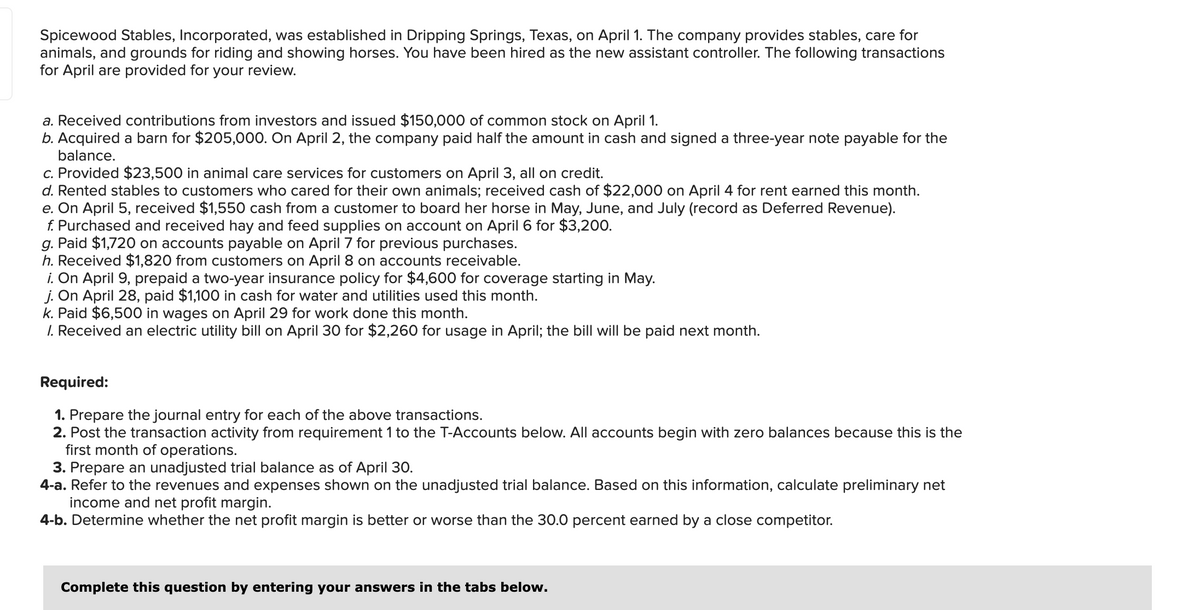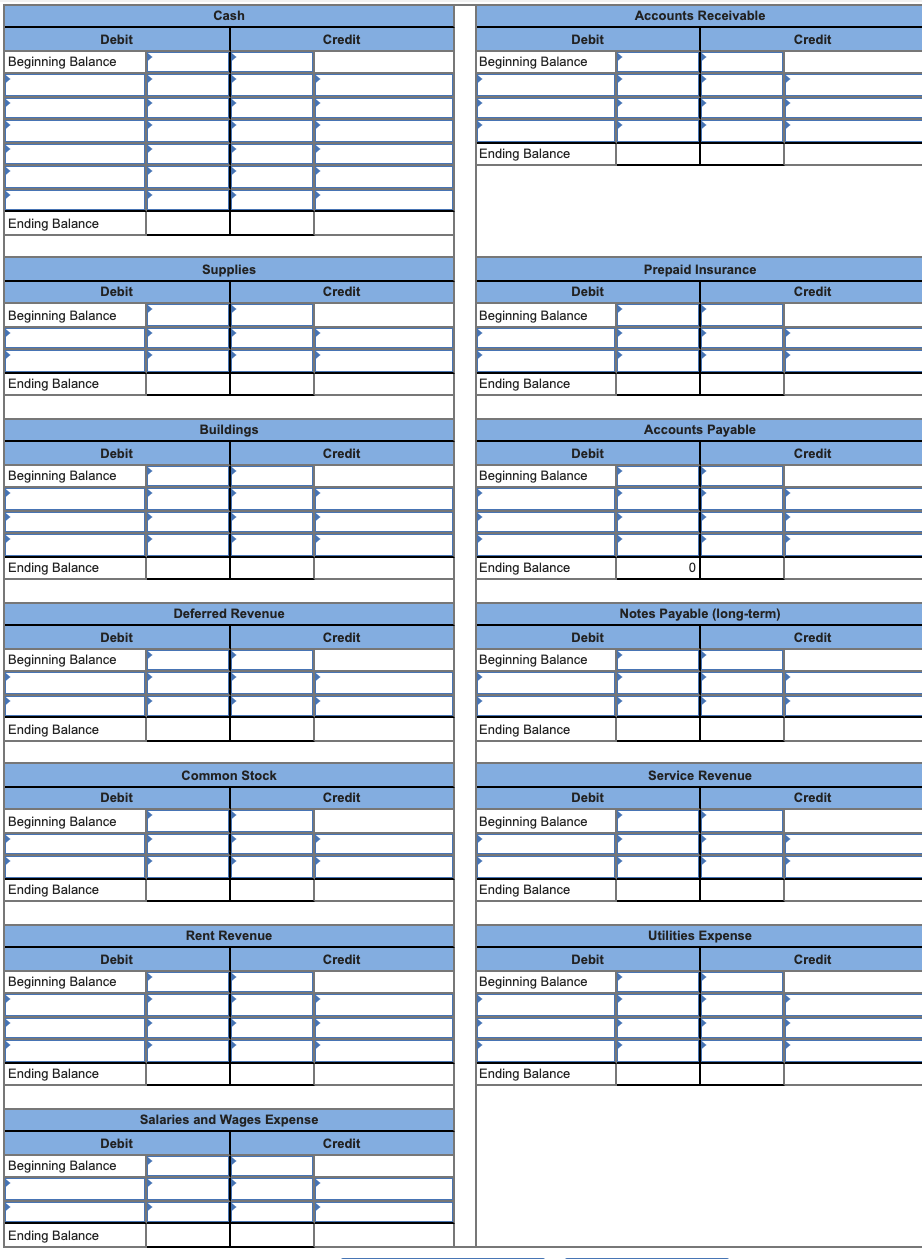Spicewood Stables, Incorporated, was established in Dripping Springs, Texas, on April 1. The company provides stables, care for animals, and grounds for riding and showing horses. You have been hired as the new assistant controller. The following transactions for April are provided for your review. a. Received contributions from investors and issued $150,000 of common stock on April 1. b. Acquired a barn for $205,000. On April 2, the company paid half the amount in cash and signed a three-year note payable for the balance. c. Provided $23,500 in animal care services for customers on April 3, all on credit. d. Rented stables to customers who cared for their own animals; received cash of $22,000 on April 4 for rent earned this month. e. On April 5, received $1,550 cash from a customer to board her horse in May, June, and July (record as Deferred Revenue). f. Purchased and received hay and feed supplies on account on April 6 for $3,200. g. Paid $1,720 on accounts payable on April 7 for previous purchases. h. Received $1,820 from customers on April 8 on accounts receivable. i. On April 9, prepaid a two-year insurance policy for $4,600 for coverage starting in May. j. On April 28, paid $1,100 in cash for water and utilities used this month. k. Paid $6,500 in wages on April 29 for work done this month. I. Received an electric utility bill on April 30 for $2,260 for usage in April; the bill will be paid next month.
Spicewood Stables, Incorporated, was established in Dripping Springs, Texas, on April 1. The company provides stables, care for animals, and grounds for riding and showing horses. You have been hired as the new assistant controller. The following transactions for April are provided for your review. a. Received contributions from investors and issued $150,000 of common stock on April 1. b. Acquired a barn for $205,000. On April 2, the company paid half the amount in cash and signed a three-year note payable for the balance. c. Provided $23,500 in animal care services for customers on April 3, all on credit. d. Rented stables to customers who cared for their own animals; received cash of $22,000 on April 4 for rent earned this month. e. On April 5, received $1,550 cash from a customer to board her horse in May, June, and July (record as Deferred Revenue). f. Purchased and received hay and feed supplies on account on April 6 for $3,200. g. Paid $1,720 on accounts payable on April 7 for previous purchases. h. Received $1,820 from customers on April 8 on accounts receivable. i. On April 9, prepaid a two-year insurance policy for $4,600 for coverage starting in May. j. On April 28, paid $1,100 in cash for water and utilities used this month. k. Paid $6,500 in wages on April 29 for work done this month. I. Received an electric utility bill on April 30 for $2,260 for usage in April; the bill will be paid next month.
Financial Accounting: The Impact on Decision Makers
10th Edition
ISBN:9781305654174
Author:Gary A. Porter, Curtis L. Norton
Publisher:Gary A. Porter, Curtis L. Norton
Chapter9: Current Liabilities, Contingencies, And The Time Value Of Money
Section: Chapter Questions
Problem 9.10E
Related questions
Question

Transcribed Image Text:Spicewood Stables, Incorporated, was established in Dripping Springs, Texas, on April 1. The company provides stables, care for
animals, and grounds for riding and showing horses. You have been hired as the new assistant controller. The following transactions
for April are provided for your review.
a. Received contributions from investors and issued $150,000 of common stock on April 1.
b. Acquired a barn for $205,000. On April 2, the company paid half the amount in cash and signed a three-year note payable for the
balance.
c. Provided $23,500 in animal care services for customers on April 3, all on credit.
d. Rented stables to customers who cared for their own animals; received cash of $22,000 on April 4 for rent earned this month.
e. On April 5, received $1,550 cash from a customer to board her horse in May, June, and July (record as Deferred Revenue).
f. Purchased and received hay and feed supplies on account on April 6 for $3,200.
g. Paid $1,720 on accounts payable on April 7 for previous purchases.
h. Received $1,820 from customers on April 8 on accounts receivable.
i. On April 9, prepaid a two-year insurance policy for $4,600 for coverage starting in May.
j. On April 28, paid $1,100 in cash for water and utilities used this month.
k. Paid $6,500 in wages on April 29 for work done this month.
I. Received an electric utility bill on April 30 for $2,260 for usage in April; the bill will be paid next month.
Required:
1. Prepare the journal entry for each of the above transactions.
2. Post the transaction activity from requirement 1 to the T-Accounts below. All accounts begin with zero balances because this is the
first month of operations.
3. Prepare an unadjusted trial balance as of April 30.
4-a. Refer to the revenues and expenses shown on the unadjusted trial balance. Based on this information, calculate preliminary net
income and net profit margin.
4-b. Determine whether the net profit margin is better or worse than the 30.0 percent earned by a close competitor.
Complete this question by entering your answers in the tabs below.

Transcribed Image Text:Cash
Accounts Receivable
Debit
Credit
Debit
Credit
Beginning Balance
Beginning Balance
Ending Balance
Ending Balance
Supplies
Prepaid Insurance
Debit
Credit
Debit
Credit
Beginning Balance
Beginning Balance
Ending Balance
Ending Balance
Buildings
Accounts Payable
Debit
Credit
Debit
Credit
Beginning Balance
Beginning Balance
Ending Balance
Ending Balance
Deferred Revenue
Notes Payable (long-term)
Debit
Credit
Debit
Credit
Beginning Balance
Beginning Balance
Ending Balance
Ending Balance
Common Stock
Service Revenue
Debit
Credit
Debit
Credit
Beginning Balance
Beginning Balance
Ending Balance
Ending Balance
Rent Revenue
Utilities Expense
Debit
Credit
Debit
Credit
Beginning Balance
Beginning Balance
Ending Balance
Ending Balance
Salaries and Wages Expense
Debit
Credit
Beginning Balance
Ending Balance
Expert Solution
This question has been solved!
Explore an expertly crafted, step-by-step solution for a thorough understanding of key concepts.
This is a popular solution!
Trending now
This is a popular solution!
Step by step
Solved in 2 steps

Recommended textbooks for you

Financial Accounting: The Impact on Decision Make…
Accounting
ISBN:
9781305654174
Author:
Gary A. Porter, Curtis L. Norton
Publisher:
Cengage Learning

Cornerstones of Financial Accounting
Accounting
ISBN:
9781337690881
Author:
Jay Rich, Jeff Jones
Publisher:
Cengage Learning

Intermediate Accounting: Reporting And Analysis
Accounting
ISBN:
9781337788281
Author:
James M. Wahlen, Jefferson P. Jones, Donald Pagach
Publisher:
Cengage Learning

Financial Accounting: The Impact on Decision Make…
Accounting
ISBN:
9781305654174
Author:
Gary A. Porter, Curtis L. Norton
Publisher:
Cengage Learning

Cornerstones of Financial Accounting
Accounting
ISBN:
9781337690881
Author:
Jay Rich, Jeff Jones
Publisher:
Cengage Learning

Intermediate Accounting: Reporting And Analysis
Accounting
ISBN:
9781337788281
Author:
James M. Wahlen, Jefferson P. Jones, Donald Pagach
Publisher:
Cengage Learning

Principles of Accounting Volume 1
Accounting
ISBN:
9781947172685
Author:
OpenStax
Publisher:
OpenStax College

College Accounting (Book Only): A Career Approach
Accounting
ISBN:
9781337280570
Author:
Scott, Cathy J.
Publisher:
South-Western College Pub

College Accounting (Book Only): A Career Approach
Accounting
ISBN:
9781305084087
Author:
Cathy J. Scott
Publisher:
Cengage Learning